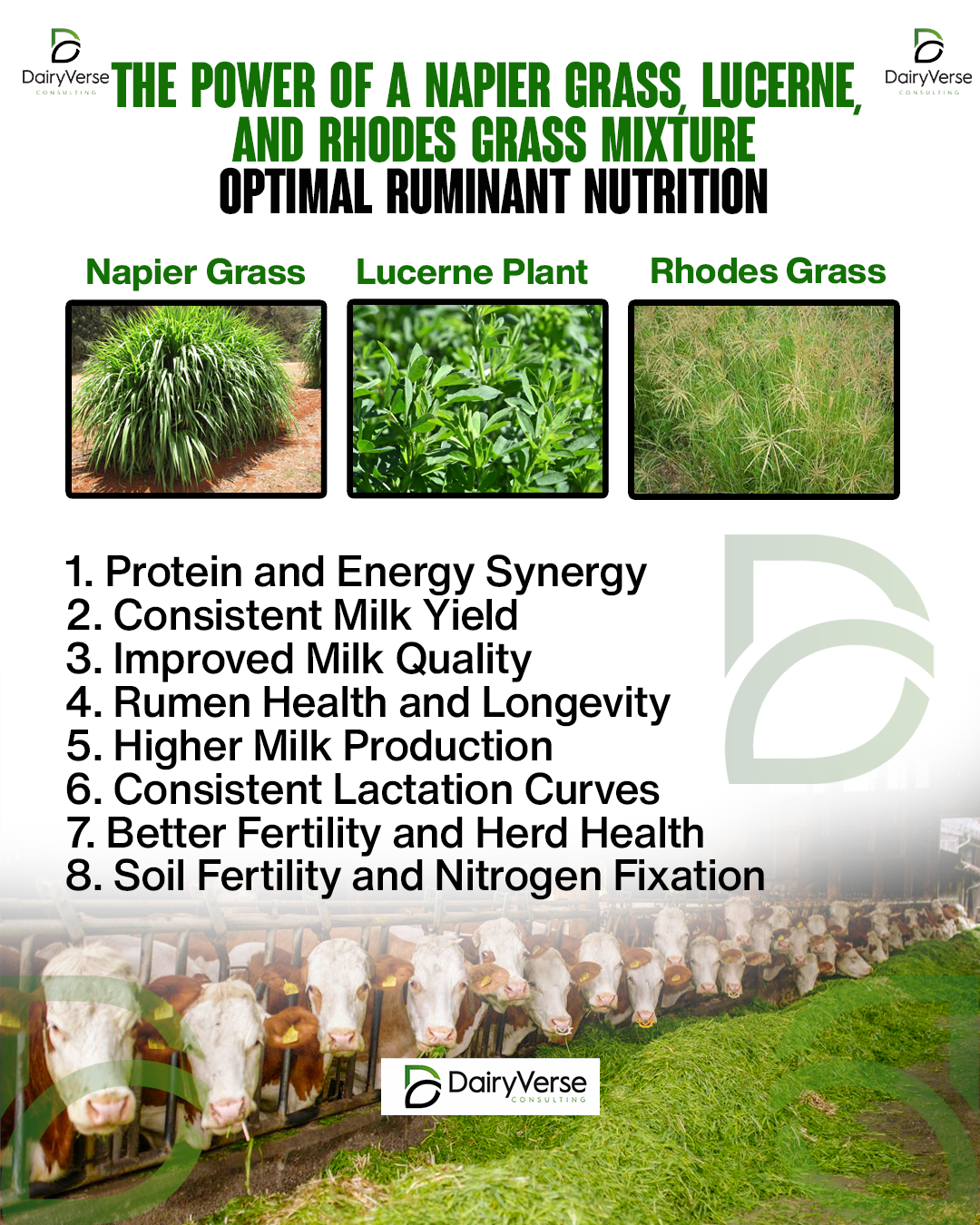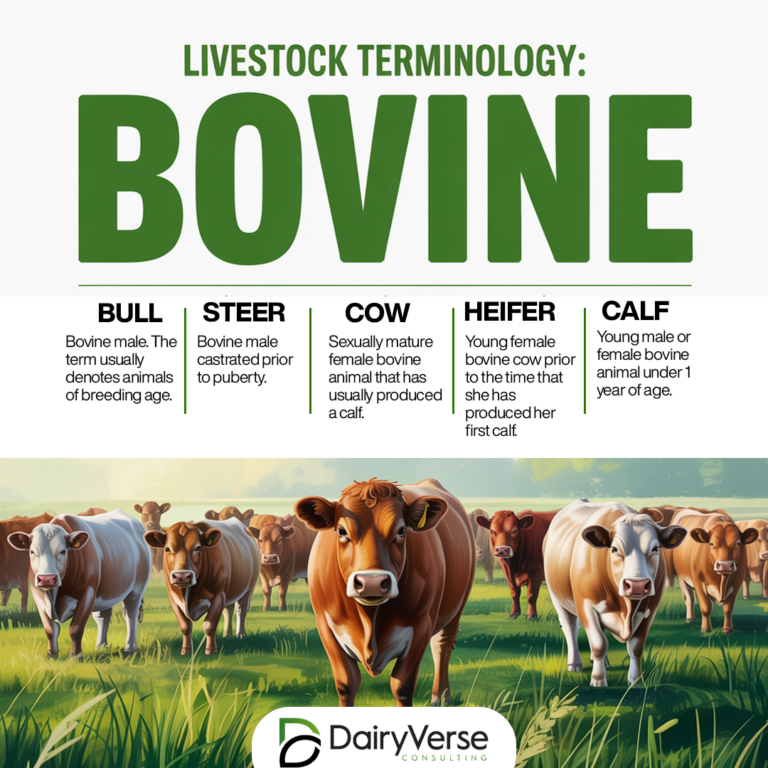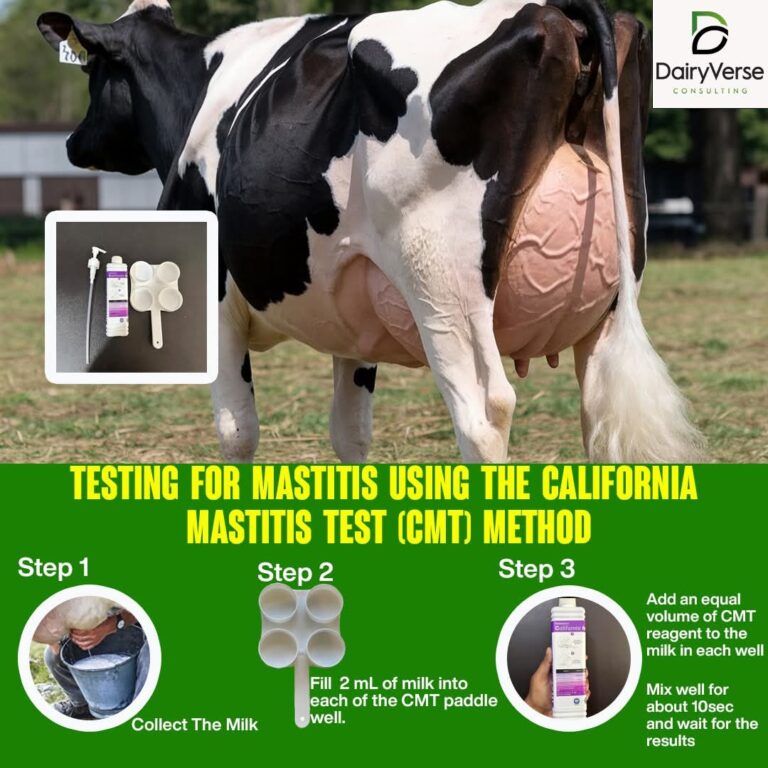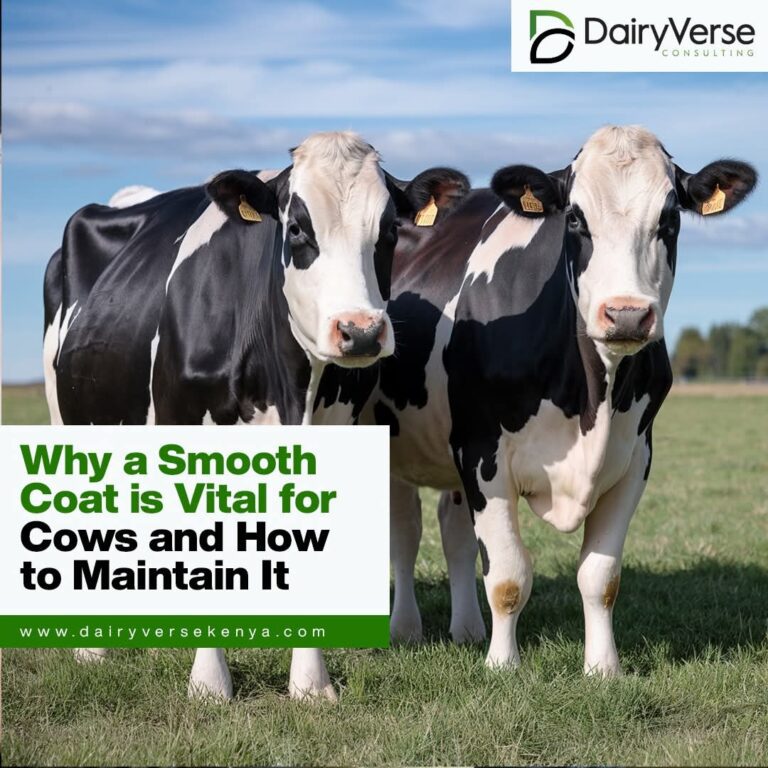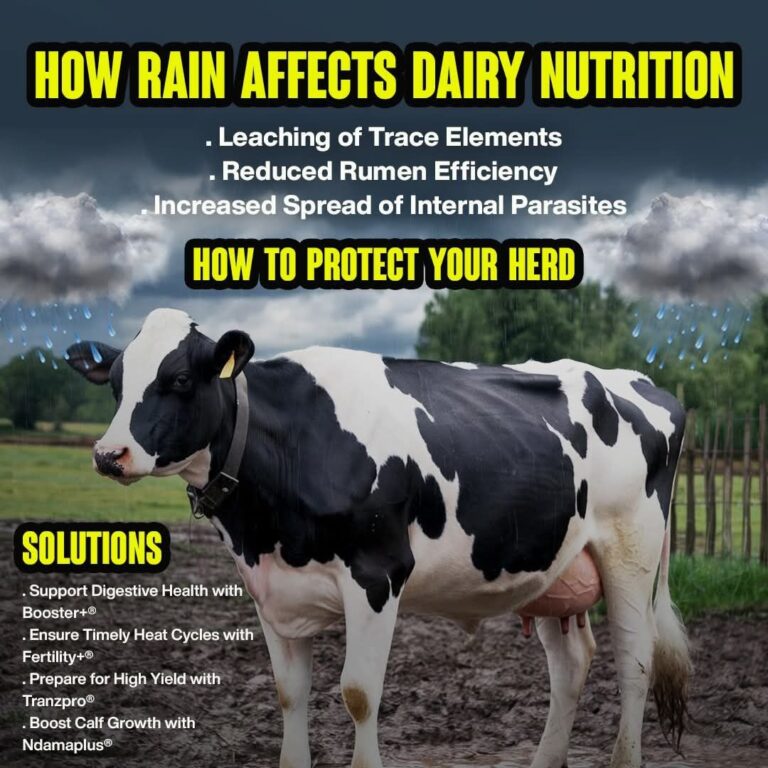Optimal Ruminant Nutrition: The Power of a Napier Grass, Lucerne, and Rhodes Grass Mixture
Napier Grass (Pennisetum purpureum)
- Key Traits: Known for prolific biomass production and rapid regrowth. Grows best in warm climates with moderate rainfall and is relatively drought-tolerant once established.
- Nutritional Profile:
- Moderate-to-high crude protein (CP) content—generally 8–12%, depending on maturity.
- Provides digestible fiber and sufficient energy if cut before it becomes overly fibrous.
1.2 Lucerne (Alfalfa, Medicago sativa)
- Key Traits: A top-tier legume for dairy diets. Deep-rooted, nitrogen-fixing, and rich in protein. Flourishes in well-drained soils with near-neutral pH.
- Nutritional Profile:
- Can exceed 20% crude protein when harvested at early bloom.
- Supplies a wide array of minerals (especially calcium), vitamins, and easily fermented fiber.
1.3 Rhodes Grass (Chloris gayana)
- Key Traits: Well-adapted to tropical/subtropical regions, with good tolerance for different soil types. Quick to establish from seed and often used in grazing or hay systems.
- Nutritional Profile:
- Moderate crude protein (8–15%, depending on maturity and soil quality).
- Adequate energy levels when managed to avoid over-maturity.
2. Why This Mix Is Ideal for Dairy Cows
2.1 Protein and Energy Synergy
- Lucerne brings high protein, critical for milk synthesis and maintaining body condition during lactation.
- Napier and Rhodes Grass provide the bulk of energy and digestible fiber that supports healthy rumen function.
- Together, they reduce the need for costly protein concentrates.
2.2 Consistent Milk Yield
- Balanced Nutritional Profile: Combining leguminous Lucerne with these grasses helps cows achieve steadier milk outputs over time.
- Stable Dry Matter Intake (DMI): Cows often eat more when offered a variety of forages, promoting higher overall nutrient consumption—which translates to increased milk volume.
2.3 Improved Milk Quality
- High-protein diets rich in essential amino acids (from Lucerne) can bolster milk protein percentages.
- Adequate fiber from Napier and Rhodes helps maintain optimal rumen pH, which can improve fat content in milk.
2.4 Rumen Health and Longevity
- Rumen Buffering: Lucerne’s mineral content (especially calcium) supports stable rumen pH, preventing subacute ruminal acidosis (SARA).
- Fiber Diversity: Napier’s and Rhodes’ fibrous structures encourage rumination (chewing cud) and saliva production, aiding digestion and nutrient absorption.
- Reduced Bloat Risk: Having Napier and Rhodes grass in the mix dilutes the risk of bloat that may occur if cows graze on pure, lush legumes alone.
3. Specific Advantages for Dairy Operations
3.1 Higher Milk Production
Research shows that dairy cows on mixed grass-legume diets often produce more milk compared to those fed single-forage diets. The synergy between legume protein and grass energy boosts feed efficiency.
3.2 Consistent Lactation Curves
Because this forage mix can sustain balanced nutrient availability over the lactation cycle, cows maintain body condition, avoid metabolic stress, and produce milk more steadily between calvings.
3.3 Better Fertility and Herd Health
- Body Condition Score (BCS): Adequate protein and energy help cows conceive more easily after calving.
- Stronger Immune Function: Good nutrition is tied to lower disease incidence (mastitis, lameness, etc.).
4. Agronomic and Environmental Benefits
4.1 Soil Fertility and Nitrogen Fixation
- Lucerne (Alfalfa) enriches the soil by fixing atmospheric nitrogen, benefiting companion grasses (Napier, Rhodes).
- Reduced synthetic fertilizer use lowers input costs and lessens environmental impact.
4.2 Stand Longevity and Yield
- Complementary Growth Patterns: Napier and Rhodes thrive under warm, moist conditions, while Lucerne’s deep root system tolerates moderate drought and stabilizes soil structure.
- Multiple Harvests: Properly timed cutting or grazing schedules can yield high forage tonnage throughout the year.
4.3 Weed Control and Erosion Prevention
- Dense, multi-species stands cover the soil, reducing weed emergence.
- Varying root architectures (deep taproots of Lucerne, fibrous roots of grasses) hold soil in place and promote healthy soil microbial life.
5. Practical Management Tips for Dairy Producers
- Establishment
- Soil Test: Lucerne performs best at pH 6.5–7.5. Amend soil with lime if needed.
- Planting:
- Napier grass is usually via cuttings.
- Rhodes grass is sown from seed.
- Lucerne sown at the recommended depth and rate, ensuring firm seedbeds.
- Cutting and Harvesting
- Napier: Best cut at 1–1.2 m for optimal nutritional content.
- Rhodes: Harvest at early flowering to maximize quality.
- Lucerne: Cut at early bloom for a high-protein yield.
- Harvest frequently enough to prevent over-maturity and maintain palatability.
- Grazing Strategies
- Rotational Grazing: Move cows before forage is grazed too low; allow enough rest for regrowth.
- Bloat Control: Provide cows with access to grass hay or partial mixed rations when grazing lush Lucerne.
- Mixed Paddocks: Keep an eye on stand composition, reseeding if one species overtakes others.
- Supplementation
- Even with Lucerne fixing nitrogen, monitor soil nutrients (especially phosphorus and potassium).
- Provide a balanced mineral mix (high calcium, phosphorus, trace minerals) based on local deficiencies.
- Observing Cow Health
- Track body condition scores and milk components. Adjust feeding schedules or forage ratios if needed.
- Maintain good hygiene (clean waterers, comfortable housing) to maximize the benefits of a high-forage diet.
Conclusion
By combining Napier Grass, Lucerne, and Rhodes Grass, dairy producers create a nutritionally balanced and palatable diet that promotes higher milk yields, better milk quality, and stronger cow health. This mix supplies ample protein, digestible fiber, and critical minerals, all while enhancing soil fertility and reducing production costs. With proper establishment, cutting or grazing management, and supplementation, dairy operations can unlock the full potential of this three-way forage blend to optimize herd productivity and profitability.

